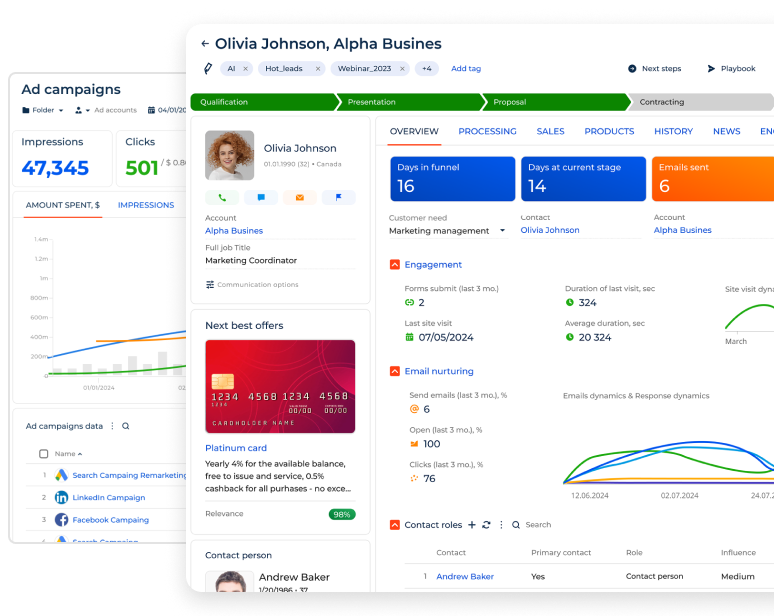-
No-Code
Platform
-
Studio
No-code agentic platform delivering the fastest time-to-value and the highest ROI
-
Studio
-
AI-Native CRM
CRM
-
AI-Native CRM
New era CRM to manage customer & operational workflows
CRM Products -
AI-Native CRM
- Industries
- Customers
- Partners
- About
Automate Funnels From Click to Close. Try Creatio

With fierce online competition and shrinking consumer attention spans, businesses need an effective strategy to convert website visitors into loyal customers. Click funnels provide a systematic way to achieve this goal by leading prospects through a carefully crafted journey that addresses their search intent, builds credibility, and ensures high conversion rates.
Discover what's the difference is between click funnels and sales funnels, and how to use a click funnel to boost your conversion and sales!
What is a Click Funnel?
A click funnel is a sequence of landing pages that lead potential customers to conversion. It involves a series of steps, from initial engagement to a final conversion event, like a purchase or sign-up for newsletter. Click funnels are essential for optimizing lead journey and increasing conversion rate by strategically directing online traffic to relevant landing pages.
Prospects typically enter click funnels through links from email campaigns, advertisements, or social media posts. These links lead them to specific landing, service, or product pages with targeted content and calls to action that encourage leads to convert.
How Does the Click Funnel Work?
A click funnel takes prospects through a series of web pages by strategically placing links that guide them from one page to another in a predesigned manner.
Prospects enter the funnel through links and are taken to a landing page with detailed information about a product or service. Next, they can click through additional pages with more content, up-sells, or cross-sells to eventually reach the conversion page. Finally, they are encouraged to take action, such as making a purchase or signing up for webinars, email newsletters, gated content, etc.
Differences Between Sales Funnel and Click Funnel
While both sales funnels and click funnels aim to convert prospects into customers, they differ significantly in structure and application.

A sales funnel is a broader concept that includes the entire customer journey, from the initial awareness stage to the final purchase, across various channels. Optimal sales funnel includes online and offline methods, such as in-person meetings, phone calls, digital media like online brochures and print media.
In contrast, a click funnel focuses specifically on the online journey, guiding potential clients through a sequence of landing pages designed to convert them into clients or sign up for additional content.
Sales funnels include multiple steps, such as lead generation, and nurturing across various touchpoints and interactions. To maximize the effectiveness of a sales funnel, businesses use a combination of CRM systems, and marketing automation tools to manage the customer journey.
Click funnels are a series of web pages with clear calls to action, making the customer journey more direct and measurable. Click funnels sometimes use specialized software to create, manage, and optimize the funnel process, track user behavior, and make real-time adjustments.
The metrics for measuring success also differ between the two. Sales funnels are evaluated using such metrics as lead quality, sales cycle length, and conversion rate to the next stage in the sales funnel. Click funnels' metrics include click-through rates, page conversions, and overall funnel efficiency.
In summary, a sales funnel provides a comprehensive overview of the client acquisition and sales process, while a click funnel offers a digital-specific approach to driving online conversions.
| Aspect | Sales Funnel | Click Funnel |
Purpose
| Covers the entire customer journey across various channels from awareness to transaction | Focuses on an online journey through web pages and increasing click-through and conversion rates |
| Steps | Multiple steps involving various channels and touchpoints | Streamlined landing pages with clear calls to action |
| Tools | CRM systems, marketing automation, and other marketing tools | Specialized software for click funnel tracking |
| Metrics | Lead quality, sales cycle length, conversion rates | Click-through rates, page conversions, funnel efficiency |
Click Funnel Example
In this part of the article, we’re going to analyze a click funnel example for an online fashion store specializing in premium clothing:
Imagine a scenario where a prospective customer discovers a social media post with paid ad highlighting the latest collection of luxury dresses. They click on the ad that redirects them to a category landing page, with all the dresses available in the shop.
As they browse, they discover a perfect dress for an upcoming wedding and click on it, which leads them to a product landing page. The landing page includes high-quality images, detailed descriptions, and reviews to help them make an informed decision.
After adding a dress to their cart, they are presented with an additional section, highlighting matching accessories such as shoes, jewelry, and handbags that complement the dress. They browse the accessories category page and choose a few items that will complete the look. While deciding on accessories, they notice a special offer: receive 10% off the total purchase when buying two or more items from the collection.
Motivated by the discount, the customer completes their purchase of the dress and matching accessories. Following the purchase, they receive a thank-you email, along with an invitation to participate in customer loyalty programs or upcoming sales events. This way, the shop ensures a positive experience and encourages the client to stay in touch with the brand.
This example demonstrates how a strategic sequence of steps can guide clients through the online shopping journey, encouraging them to explore complementary items, increase their order value with discounts, and build lasting engagement.
How to Create a Click Funnel
Creating click funnels involves relying on a structured approach to guide prospective customers through a series of steps designed to convert them into clients. This process is essential for optimizing online marketing efforts and maximizing sales.
Below, we'll explore the key steps involved in a typical funnel builder:

Step 1. Define your goal and target audience
Before diving into creating a click funnel, it's crucial to define your specific goal and identify your target audience. Your goal could be to generate leads, sell a product or service, increase webinar sign-ups, or any other desired action.
Understanding your audience - their demographics, interests, pain points, and buying behavior - will help you tailor your marketing strategy and funnel content to address their needs and motivations. By doing so, you can create a more personalized and engaging experience that resonates with your prospective customers, guiding them smoothly through each stage of your click funnel.
Step 2. Create a compelling landing page
Landing pages are the cornerstone of click funnels. They should be designed to capture attention, provide relevant information, and encourage action.
Key elements of an effective landing page include:
- Clear and compelling headline - immediately communicates the value of your proposition.
- Engaging visuals - high-quality images or videos that showcase your product or service will encourage prospects to purchase.
- Concise copy - clearly explain the benefits and features, so potential customers can make an informed decision.
- Call to action (CTA) - direct visitors to take the next step, such as signing up, making a purchase, or registering for an event.
- Lead capture form - if applicable, add a form to collect visitor information such as name and email.
Optimizing your website for conversions involves A/B testing of the mentioned elements to see what resonates best with your audience and drives the highest conversion rates.
Step 3. Implement up-sell and cross-sell strategies
Maximize the value of a prospective customer by incorporating add-ons like up-sell and cross-sell within your click funnel.
Up-selling involves encouraging customers to purchase a more expensive or premium version of the product they're interested in. Cross-selling suggests related products or accessories that complement their initial purchase.
Effective strategies include:
- Product bundling - offer a discount when customers buy multiple related products together.
- Limited-time offers - create urgency with time-sensitive deals to prompt immediate action.
- Personalized recommendations - use client purchase history or browsing behavior in targeted marketing to suggest relevant products.
You can increase the average order value and satisfaction of prospective customers by strategically placing up-sell and cross-sell offers at relevant points in the sales funnel.
Step 4. Develop a follow-up email sequence
Once prospects enter your funnel by taking the initial action (like signing up or making a purchase), it's essential to nurture these leads through a well-crafted email sequence.
The sequence should be designed to provide value, and guide leads toward the next stage of the funnel or their next purchase. It's also a great way to transform a one-time buyer into a loyal customer by consistently engaging them with personalized offers, relevant content, and exceptional service that reinforces their decision to choose your brand.
Step 5. Monitor and optimize
Continuous monitoring and optimization are crucial to the success of your click funnels. Use analytics tools to track key performance indicators (KPIs) such as conversion rates and click-through rates.
Analyze data to identify bottlenecks or areas for improvement within your funnel and make data-driven decisions to optimize conversions. Regularly review and refine your click funnels to ensure they help you meet your business goals.
Creating a click funnel involves strategic planning, thoughtful execution, and ongoing optimization to guide prospects seamlessly from initial interest to conversion. By understanding your audience, crafting compelling content, and leveraging analytical tools, businesses can build effective click funnels that drive sales and increase customer engagement.
Boost Your Sales Strategy with Creatio
Businesses can effectively increase conversions, maximize customer lifetime value, and build stronger brand loyalty by strategically guiding prospects through well-designed click funnels. To improve your efforts, you can leverage Customer Relationship Management (CRM) tools like Creatio CRM to streamline and optimize the click funnel processes.
Creatio CRM offers robust features designed to manage leads, automate marketing campaigns, track customer interactions, and analyze sales teams’ performance. With its intuitive interface and powerful analytics, Creatio CRM empowers businesses to create personalized customer journeys, boost sales team collaboration, and drive revenue growth.

By integrating Creatio CRM into the click funnel strategy, you can gain deeper insights into customer behavior, streamline sales processes, and nurture leads more effectively. Implementing click funnels coupled with advanced Creatio CRM technology will help you create an effective sales strategy to set your business for long-term growth and success in today’s dynamic digital marketplace.






















































